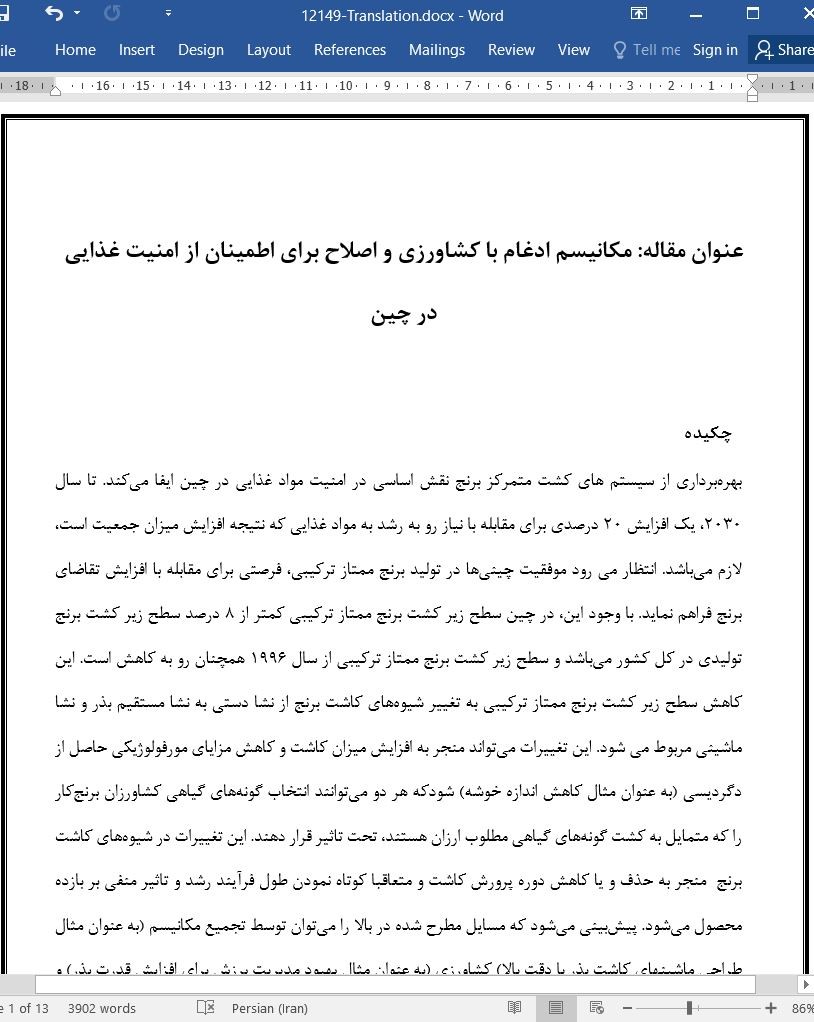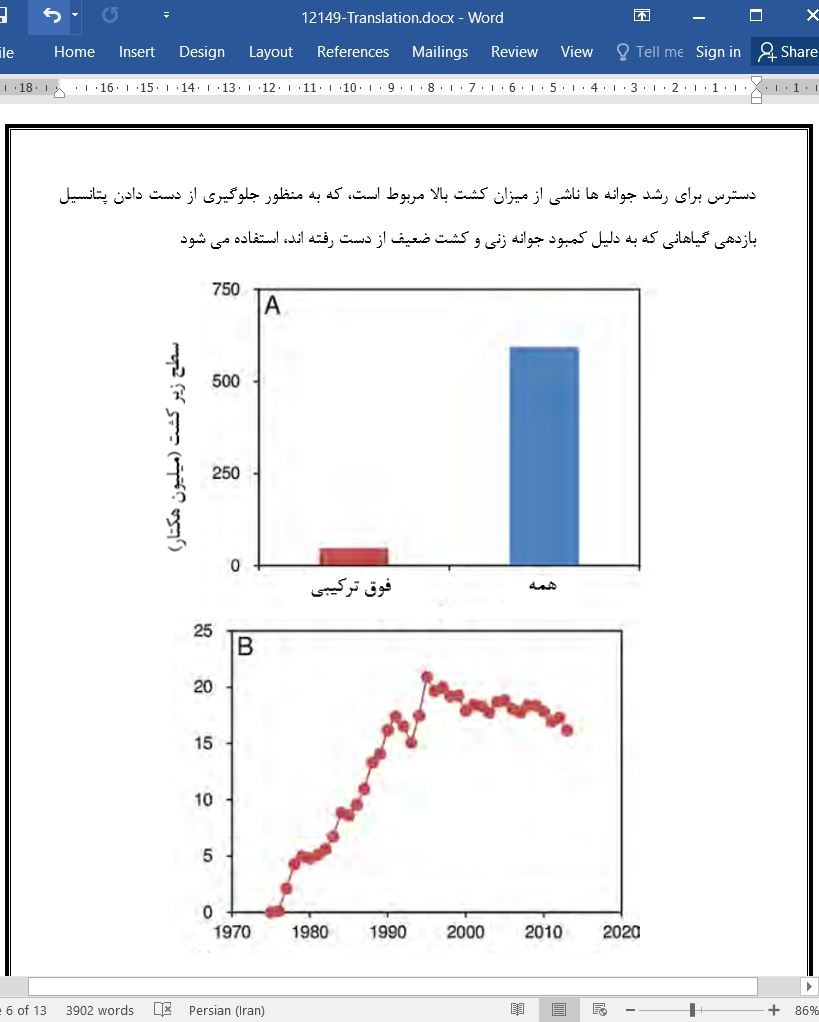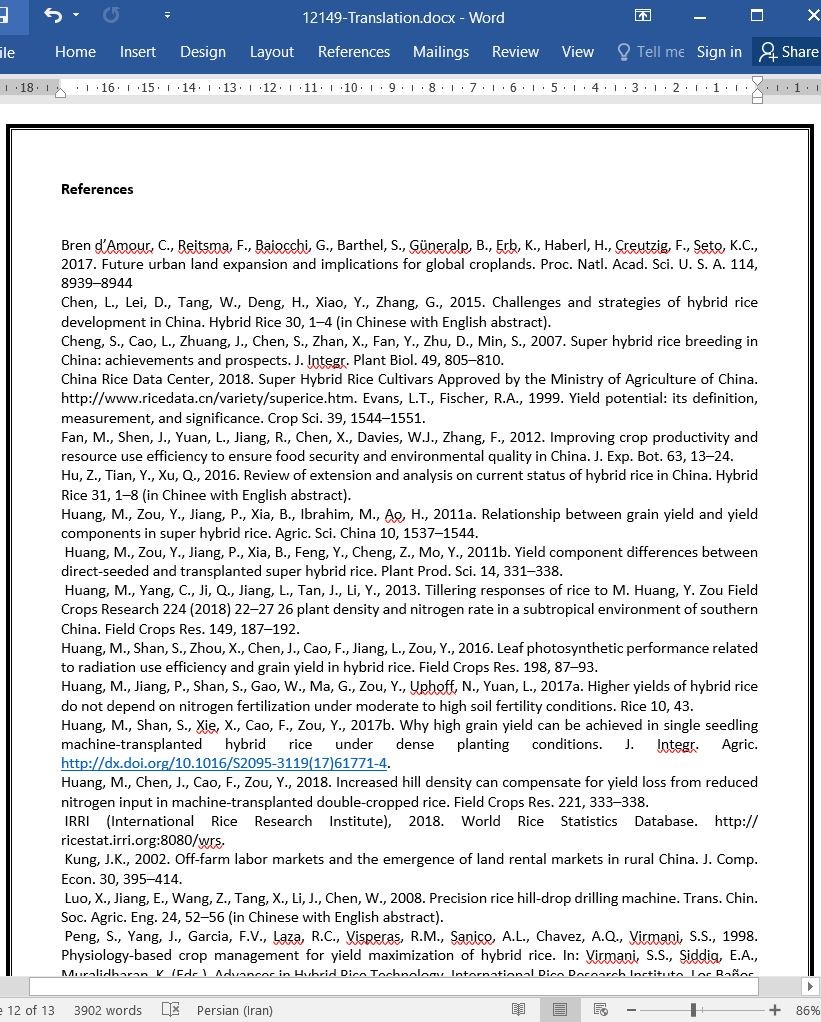
مکانیسم ادغام با کشاورزی و اصلاح برای اطمینان از امنیت غذایی در چین
چکیده
بهره برداری از سیستم های کشت متمرکز برنج نقش اساسی در امنیت مواد غذایی در چین ایفا می کند. تا سال 2030، یک افزایش 20 درصدی برای مقابله با نیاز رو به رشد به مواد غذایی که نتیجه افزایش میزان جمعیت است، لازم می باشد. انتظار می رود موفقیت چینی ها در تولید برنج ممتاز ترکیبی، فرصتی برای مقابله با افزایش تقاضای برنج فراهم نماید. با وجود این، در چین سطح زیر کشت برنج ممتاز ترکیبی کمتر از 8 درصد سطح زیر کشت برنج تولیدی در کل کشور می باشد و سطح زیر کشت برنج ممتاز ترکیبی از سال 1996 همچنان رو به كاهش است. این کاهش سطح زیر کشت برنج ممتاز ترکیبی به تغییر شیوه های کاشت برنج از نشا دستی به نشا مستقیم بذر و نشا ماشینی مربوط می شود. این تغییرات می تواند منجر به افزایش میزان کاشت و کاهش مزایای مورفولوژیکی حاصل از دگردیسی (به عنوان مثال کاهش اندازه خوشه) شودکه هر دو می توانند انتخاب گونه های گیاهی کشاورزان برنج کار را که متمایل به کشت گونه های گیاهی مطلوب ارزان هستند، تحت تاثیر قرار دهند. این تغییرات در شیوه های کاشت برنج منجر به حذف و یا کاهش دوره پرورش کاشت و متعاقبا کوتاه نمودن طول فرآیند رشد و تاثیر منفی بر بازده محصول می شود. پیش بینی می شود که مسایل مطرح شده در بالا را می توان توسط تجمیع مکانیسم (به عنوان مثال طراحی ماشینهای کاشت بذر با دقت بالا) کشاورزی (به عنوان مثال بهبود مدیریت برزش برای افزایش قدرت بذر) و پرورش (به عنوان مثال توسعه گونه های گیاهی پربازده با دوره رشد کوتاه) برطرف نمود. این استراتژی همچنین برای تولید سایر محصولات در سیستم های کشاورزی متمرکز در چین و سایر کشورهای در حال توسعه با سیستم کشت متمرکز مبتنی بر پایه برنج کاربرد دارد.
1. چالش های تولید برنج به جهت اطمینان از امنیت غذایی در چین
کشور چین با داشتن 22 درصد جمعیت جهان، تنها 7 درصد از زمین های زراعتی جهان را دارد (پیو و همکاران، 2010). به منظور تولید مواد غذایی کافی، سیستم های کاشت متمرکز به طور گسترده ای در چین توسعه داده شده است. پیشرفت قابل توجهی بواسطه توسعه کاشت گونه های گیاهی پربازده و بهبود برزش مدیریت محصول ایجاد شده است. در نتیجه پیشرفت بسیار خوبی در هر دو زمینه تولید محصولات و امنیت غذایی در چین حاصل شده است (فان و همکاران، 2012).
Abstract
Productivity of intensive rice cropping systems plays a pivotal role in national food security in China. By 2030, a 20% increase in rice yield will be required to meet the growing demand for food that will result from population growth. The success of China’s super hybrid rice was expected to provide an opportunity to cope with the increased demand for rice. However, in China the planting area of super hybrid rice is less than 8% of the national total rice planting area and the planting area of hybrid rice has continued to decline since 1996. The decreased planting area of hybrid rice is related to the shift in rice establishment methods from manual transplanting to direct seeding and mechanical transplanting. These shifts can result in increased seeding rates and reduced morphological advantages of heterosis (e.g. reduced panicle size), both of which can influence cultivar choice by rice farmers, who will tend to favor cheaper inbred cultivars. The shifts in rice establishment methods can also eliminate or reduce the seedling nursey period and subsequently shorten the growth duration and negatively affect the yield. We anticipate that the above problems will be resolved by integrating mechanization (e.g. designing high-precision seed sowing machines) with agronomy (e.g. improving management practices for increasing seed vigor) and breeding (e.g. developing high-yielding cultivars with short growth durations). This strategy also has implications for production of other crops in intensive farming systems in China and for other developing countries with rice-based intensive cropping systems.
1. Challenges to rice production for ensuring food security in China
China has 22% of the world’s population but only 7% of the world’s arable land (Piao et al., 2010). In order to produce enough food, intensive cropping systems have been extensively developed in China. Considerable progress has been made by developing high-yielding crop cultivars and improving crop management practices. As a result, there has been remarkable growth in both crop production and national food security in China (Fan et al., 2012).
چکیده
1. چالش های تولید برنج به جهت اطمینان از امنیت غذایی در چین
2. محدودیت های افزایش تولید برنج در چین
3. راهکارهای بهبود تولید برنج در چین
منابع
ABSTRACT
1. Challenges to rice production for ensuring food security in China
2. Constraints in increasing rice production in China
3. Strategies for improving rice production in China
References
- اصل مقاله انگلیسی با فرمت ورد (word) با قابلیت ویرایش
- ترجمه فارسی مقاله با فرمت ورد (word) با قابلیت ویرایش، بدون آرم سایت ای ترجمه
- ترجمه فارسی مقاله با فرمت pdf، بدون آرم سایت ای ترجمه



